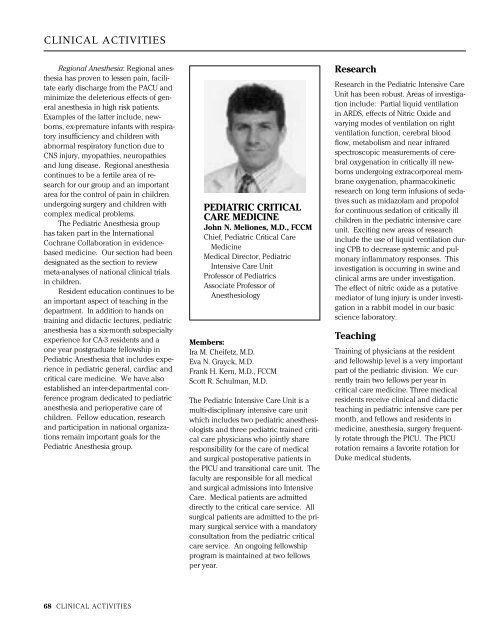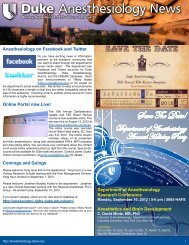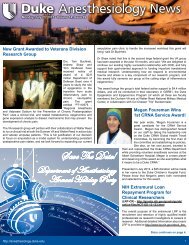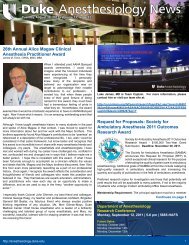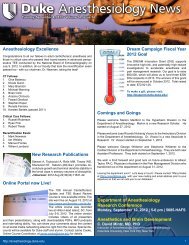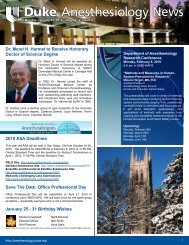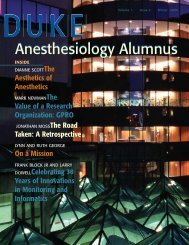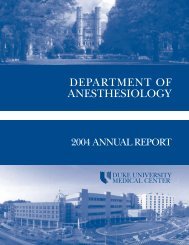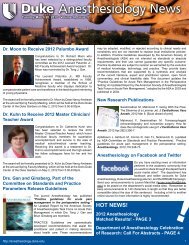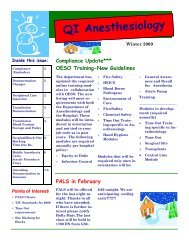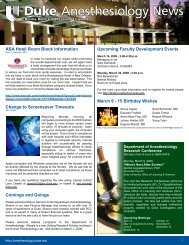DEPARTMENT OF ANESTHESIOLOGY ANNUAL REPORT
DEPARTMENT OF ANESTHESIOLOGY ANNUAL REPORT
DEPARTMENT OF ANESTHESIOLOGY ANNUAL REPORT
You also want an ePaper? Increase the reach of your titles
YUMPU automatically turns print PDFs into web optimized ePapers that Google loves.
CLINICAL ACTIVITIES<br />
Regional Anesthesia: Regional anesthesia<br />
has proven to lessen pain, facilitate<br />
early discharge from the PACU and<br />
minimize the deleterious effects of general<br />
anesthesia in high risk patients.<br />
Examples of the latter include, newborns,<br />
ex-premature infants with respiratory<br />
insufficiency and children with<br />
abnormal respiratory function due to<br />
CNS injury, myopathies, neuropathies<br />
and lung disease. Regional anesthesia<br />
continues to be a fertile area of research<br />
for our group and an important<br />
area for the control of pain in children<br />
undergoing surgery and children with<br />
complex medical problems.<br />
The Pediatric Anesthesia group<br />
has taken part in the International<br />
Cochrane Collaboration in evidencebased<br />
medicine. Our section had been<br />
designated as the section to review<br />
meta-analyses of national clinical trials<br />
in children.<br />
Resident education continues to be<br />
an important aspect of teaching in the<br />
department. In addition to hands on<br />
training and didactic lectures, pediatric<br />
anesthesia has a six-month subspecialty<br />
experience for CA-3 residents and a<br />
one year postgraduate fellowship in<br />
Pediatric Anesthesia that includes experience<br />
in pediatric general, cardiac and<br />
critical care medicine. We have also<br />
established an inter-departmental conference<br />
program dedicated to pediatric<br />
anesthesia and perioperative care of<br />
children. Fellow education, research<br />
and participation in national organizations<br />
remain important goals for the<br />
Pediatric Anesthesia group.<br />
68 CLINICAL ACTIVITIES<br />
PEDIATRIC CRITICAL<br />
CARE MEDICINE<br />
John N. Meliones, M.D., FCCM<br />
Chief, Pediatric Critical Care<br />
Medicine<br />
Medical Director, Pediatric<br />
Intensive Care Unit<br />
Professor of Pediatrics<br />
Associate Professor of<br />
Anesthesiology<br />
Members:<br />
Ira M. Cheifetz, M.D.<br />
Eva N. Grayck, M.D.<br />
Frank H. Kern, M.D., FCCM<br />
Scott R. Schulman, M.D.<br />
The Pediatric Intensive Care Unit is a<br />
multi-disciplinary intensive care unit<br />
which includes two pediatric anesthesiologists<br />
and three pediatric trained critical<br />
care physicians who jointly share<br />
responsibility for the care of medical<br />
and surgical postoperative patients in<br />
the PICU and transitional care unit. The<br />
faculty are responsible for all medical<br />
and surgical admissions into Intensive<br />
Care. Medical patients are admitted<br />
directly to the critical care service. All<br />
surgical patients are admitted to the primary<br />
surgical service with a mandatory<br />
consultation from the pediatric critical<br />
care service. An ongoing fellowship<br />
program is maintained at two fellows<br />
per year.<br />
Research<br />
Research in the Pediatric Intensive Care<br />
Unit has been robust. Areas of investigation<br />
include: Partial liquid ventilation<br />
in ARDS, effects of Nitric Oxide and<br />
varying modes of ventilation on right<br />
ventilation function, cerebral blood<br />
flow, metabolism and near infrared<br />
spectroscopic measurements of cerebral<br />
oxygenation in critically ill newborns<br />
undergoing extracorporeal membrane<br />
oxygenation, pharmacokinetic<br />
research on long term infusions of sedatives<br />
such as midazolam and propofol<br />
for continuous sedation of critically ill<br />
children in the pediatric intensive care<br />
unit. Exciting new areas of research<br />
include the use of liquid ventilation during<br />
CPB to decrease systemic and pulmonary<br />
inflammatory responses. This<br />
investigation is occurring in swine and<br />
clinical arms are under investigation.<br />
The effect of nitric oxide as a putative<br />
mediator of lung injury is under investigation<br />
in a rabbit model in our basic<br />
science laboratory.<br />
Teaching<br />
Training of physicians at the resident<br />
and fellowship level is a very important<br />
part of the pediatric division. We currently<br />
train two fellows per year in<br />
critical care medicine. Three medical<br />
residents receive clinical and didactic<br />
teaching in pediatric intensive care per<br />
month, and fellows and residents in<br />
medicine, anesthesia, surgery frequently<br />
rotate through the PICU. The PICU<br />
rotation remains a favorite rotation for<br />
Duke medical students.


